
Intersections in real time: the decision to build the KH-11 KENNEN reconnaissance satellite (part 1)by Dwayne A. Day
|
| The need for near-real-time reconnaissance capability was often stated by intelligence and military officials throughout the 1960s—sometimes after key events like the Cuban Missile Crisis, the Six-Day War, or the invasion of Czechoslovakia—but was never clearly prioritized. |
For as long as these satellites have been in operation—seventeen have been launched in the past four decades—American presidents have been users of their products. One day after he was sworn in, on January 21, 1977 President Jimmy Carter was in the Oval Office when the head of the CIA came in to brief him. Acting Director of Central Intelligence E. Henry Knoche showed Carter something extraordinary: satellite photos taken the day before of his inauguration. The photos had been produced by a brand new KH-11 KENNEN satellite that had been launched atop a Titan IIID rocket from California’s Vandenberg Air Force Base in December.[1] KENNEN had been developed by the CIA as part of the National Reconnaissance Office (NRO). The large spacecraft, roughly the size and shape of the Hubble Space Telescope launched in 1990, was built by Lockheed, which had built almost all prior photo-reconnaissance satellites, and the powerful optical system was manufactured by Eastman Kodak, which had much experience with large aperture space optics.
The KENNEN was revolutionary, capable of sending its images back to a ground station outside Washington, DC in near-real-time. This was a dramatic improvement over previous satellites that had returned their film to Earth in capsules so that it could be developed and reach the light tables of photo-interpreters days, or even weeks after the photos had been taken. Today, descendants of the KENNEN continue to operate in orbit, some of them having lasted nearly two decades in orbit.
The decision to develop the KH-11 KENNEN was a long and complicated one. It is a story of competing advocates for different technologies and spacecraft. It is a story of in-fighting and disagreement as well as perseverance by a few key intelligence officials and government advisors. The story is not a clear case of intelligence requirements driving technology development, or of technology advances leading to development approval, but a mix of both, with advocates for multiple technical approaches to improving satellite imagery response time competing to gain approval to develop their preferred system.
A surprising aspect of the story is that obtaining satellite imagery faster was not a high priority for senior government officials during the first decade of satellite reconnaissance. The need for near-real-time reconnaissance capability was often stated by intelligence and military officials throughout the 1960s—sometimes after key events like the Cuban Missile Crisis, the Six-Day War, or the invasion of Czechoslovakia—but was never clearly prioritized. Intelligence officials could not agree on the desirability of what was called “warning,” “indication,” or “crisis monitoring” intelligence, or how quickly such imagery was required: was it an hour, or a few days? Although the first KENNEN satellite was successful—the presidential inauguration photos proved it—many people had been opposed to its development. But some in the CIA and scientific advisory groups wanted it—particularly intelligence advisor, inventor, and businessman Edwin “Din” Land—and prevailed after a long struggle that began many years before President Carter saw those photos from orbit.
In 1963, Albert “Bud” Wheelon, then a senior CIA official in charge of developing new intelligence technologies, including reconnaissance satellites, was sitting at home near Washington, DC watching a football game on television when he had a revelation: if he could watch a show being broadcast over a communications satellite, it should be possible to transmit images around the globe for intelligence purposes. His experience in the Cuban Missile Crisis, as well as Soviet maneuvers in Eastern Europe, had showed him “how irrelevant satellite systems were to current intelligence and crisis management,” Wheelon said in an interview for Jeff Richelson’s 2001 book The Wizards of Langley.
Wheelon’s revelation led to a directive to CIA official Leslie Dirks to “build a near-real-time system and bring photography into the current intelligence arena.”[2] Wheelon decided that the CIA’s Directorate of Science and Technology (DS&T) should develop it, and the program was soon given the code name “ZOSTER.” Despite this 1963 directive, it took another eight years before formal approval for satellite development was granted by presidential order, and 13 years before it finally flew.
| If Wheelon could watch a show being broadcast over a communications satellite, it should be possible to transmit images around the globe for intelligence purposes. |
In its very early days, ZOSTER was a technology development program to create image-producing sensors. Today billions of people carry around cellphones equipped with powerful inexpensive digital imaging sensors. But in the early 1960s, the technology was very limited, and analog. The reconnaissance satellites that the CIA previously developed in the late 1950s used film to record their images, which meant that it could be days or even weeks before a photograph was looked at by a set of eyes on the ground. Film was a powerful data storage device, capable of capturing thousands of high-quality images in a short period of time. Film-based satellite reconnaissance was good for strategic assessment—counting bombers, missiles, and submarines—but not for warnings and indications; revealing what the adversary was up to right now.
Sometime after issuing his directive, Wheelon and Dirks visited AT&T’s Bell Labs in New Jersey to take a peek at something the company was working on. The visit was actually a special favor from Bell Labs president William O. Baker, who was also a member of the President’s Foreign Intelligence Advisory Board (PFIAB) and therefore intimately familiar with the requirements for reconnaissance satellites. Although AT&T rarely allowed outsiders to see their research and development work, Baker understood its possible value in overhead reconnaissance. Wheelon and Dirks saw work being done on charge-coupled devices (CCDs), which AT&T hoped would serve as a key technology in videophones. Such technology was not mature in 1963, but Dirks realized that it could be developed and perhaps deployed in a satellite in a decade.[3] There was a clear commercial value to the technology, and the degree to which the CIA funded the early development of CCD technology is still unknown, but CIA officials were excited about what the technology could do for intelligence collection.
Wheelon’s directive to Les Dirks was one of several that the brilliant engineer initiated in 1963 that had far-reaching consequences for the development of national reconnaissance in the United States, eventually leading to powerful intelligence satellites that began operating in the 1970s. It was also one of several new initiatives that set the CIA at odds with the National Reconnaissance Office (NRO), which had been created in 1962 and was ostensibly in charge of managing national reconnaissance systems. The CIA was a participant in the NRO along with the US Air Force. The CIA’s Office of Development and Engineering, technically part of the NRO, was based at Langley Headquarters in Virginia and designated as NRO “Program B.” The Secretary of the Air Force Special Projects Office (SAFSP), based in Los Angeles, was designated as the NRO’s “Program A.” But despite Program B’s residence within the NRO, Wheelon and his CIA cohorts had their own ideas of what the priorities for national reconnaissance systems should be, and they also had a rather dim view of the NRO, its leadership, many of the people who worked for it, and SAFSP-Program A. The CIA established its own priorities and initiated its own programs, didn’t let the NRO get in their way, and sometimes never even bothered to inform the NRO leadership what they were doing.
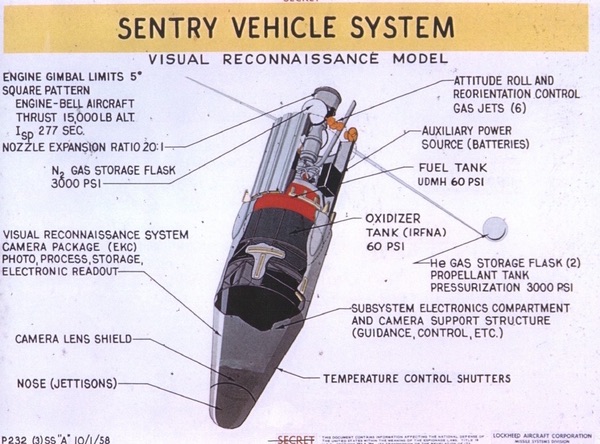 Late 1950s artist impression of a Sentry reconnaissance satellite. Sentry—soon renamed Samos—used film that was developed onboard the spacecraft, scanned, and relayed to a ground station. (credit: NRO) |
The concept of a satellite capable of relaying the images it took back to a ground station relatively quickly was as old as the concept of satellite reconnaissance. In 1946, Project RAND, working under contract to the Army Air Forces, had proposed a satellite powered by a small nuclear reactor and equipped with a television camera for taking images that could be relayed to a ground station. By 1956, the Air Force rejected the television camera in favor of a system that used film that was exposed and developed on board the satellite, scanned with a “flying spot scanner,” and the images converted to an analog signal that was transmitted to Earth while the satellite was in view of a ground station. The first reconnaissance satellite, initially named Sentry and later renamed Samos (which was not an acronym) used this technology.[4] The first camera system was designated the Samos E-1 by the Air Force, which planned to replace it with a slightly more capable version designated the Samos E-2.
In January 1960, 11 development-operational flights for E-1 and E-2 were planned by the Air Force. By August, that number had been reduced to six, and it was further cut to five by November.[5] In the meantime, the first successful CORONA film-return mission had occurred in August 1960 after a long and frustrating series of failures. Although CORONA’s images were blurry and low-resolution, many in the intelligence community believed film return represented the future of satellite reconnaissance.
| A film-return satellite could photograph 100 targets a day for three days and make all of its photographs available three days after recovery; an equivalent readout system would require 40 days of reliable operations to provide the same data. |
The advocates for Samos readout in 1960 tended to be on the Air Force’s Air Staff and at Strategic Air Command (SAC). SAC leadership in particular wanted a SAC-owned system rather than something outside their operational control.[6] When Samos images were transmitted to the ground, the images had to be processed and turned into paper copies. The data processing system for Samos, known as Subsystem I (letter, not the Roman numeral), had suffered delays and grown in cost over the past year.[7] SAC’s headquarters in Omaha, Nebraska, was the planned site of a Samos processing center.
The first Samos E-1 launch ended in failure in October 1960. The second successfully reached orbit in January 1961. The Samos E-1 returned imagery of 100-foot (30-meter) ground resolution from a 260-nautical-mile (482-kilometer) orbit, but the flight was cut short due to a failure. Although it worked, less than two weeks after the mission plans for further E-1 launches were canceled.[8]
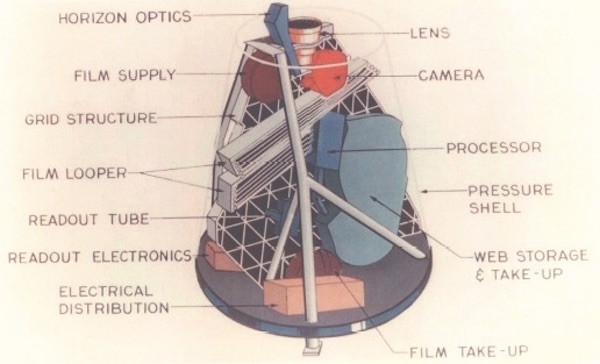 Artist impression of a Samos reconnaissance satellite system. Images were exposed on film, which was developed inside a pressurized container, scanned, and relayed to the ground. The system was severely limited in the number of images it could transmit. (credit: NRO) |
The first Samos E-2 launch took place in September 1961, but its Atlas rocket blew up on the launch pad. The Samos E-2 film processing, data transmission, and ground equipment were only modest improvements over E-1, and were still experiencing problems in mid-1961.[9] But even if these problems were solved, the limitations of Samos’ technology were increasingly apparent, and the Samos office had already initiated two new film-return programs, the E-5 and E-6. By the time of the September 1961 E-2 launch failure, program officials had lost faith in readout technology in general and the Samos E-2 in particular.[10]
Colonel William King, who was in charge of Samos and well-respected within the reconnaissance community, wrote a report that admitted that Samos readout was a dead end. King argued that an effective system required a capability for long orbital life, heavy payloads, rockets capable of launching heavy payloads, and an effective ground-based readout facility.[11] A film-return satellite could photograph 100 targets a day for three days and make all of its photographs available three days after recovery; an equivalent readout system would require 40 days of reliable operations to provide the same data. In addition, film-return systems offered greater potential for resolution improvements, meaning the ability to photograph smaller targets.[12]
“In summary,” King wrote, “I don’t favor diluting any of our [current] efforts [to develop a capable recovery system in order] to build a readout gadget. Despite the effort to get into readout and electrostatic tapes, etc., I’d say it was a wasteful effort. Started now it would chug along and we would cancel it later anyhow,” King wrote.[13] King’s reputation and his position as head of the program he was criticizing led to his report being taken seriously, despite the desire by Air Force and SAC generals for a satellite readout system. Samos E-1 and E-2 were soon canceled.
Although readout was dead by early 1962, the October 1962 Cuban Missile Crisis revived interest in readout in part because of the success of the classified NRO P-35 weather satellite, which used a television system to return images of clouds. These periodic expressions of interest in readout happened after every crisis, but never lasted for long.[14]
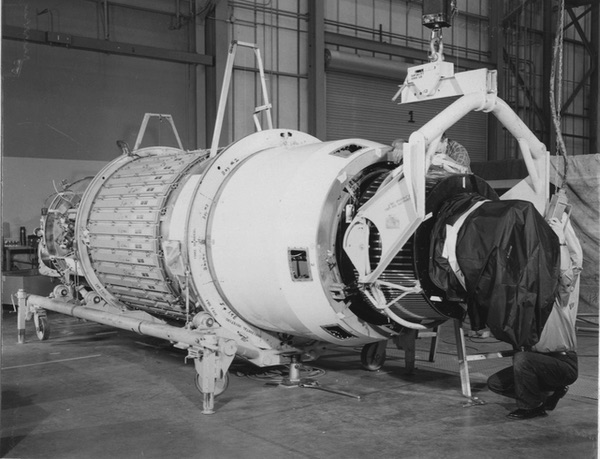 Samos reconnaissance satellite during final processing in the early 1960s. The camera, along with an additional signals intelligence payload, is covered by a shroud. (credit: USAF) |
Following King’s letter on satellite readout, Brigadier General Robert Greer, who was responsible for the Air Force reconnaissance satellite program, performed his own calculations and determined that ten ground stations would be needed to support two readout satellites in orbit to provide the same information produced by a single three-day CORONA mission. This was a substantial and expensive amount of infrastructure.[15]
Even with the cancellation of the Samos E-1 and E-2, readout technology still had some potential for growth. King and his people determined that a system with four-foot resolution could be constructed with a readout time of only about nine seconds per frame compared to the five to eight minutes per frame transmission time needed for the Samos E-2.[16] But this was still insufficient for intelligence needs.
There had been other aborted efforts to produce readout systems using different technology. The most notable of these was the Samos E-3 camera system, which had been started around 1958, during a period when the Advanced Research Projects Agency (ARPA) briefly had authority over military space programs. Instead of using film and developing it onboard the spacecraft, the camera would instead record images on “electrostatic tape.” The electrostatic tape system proposed for Samos E-3 was theoretically capable of transmitting in about one-sixth the time of the Samos E-1, and the tape was reusable.[17] Samos E-3 was canceled on order of the Air Staff when Samos control was transferred from ARPA back to the Air Force in 1959. According to NRO historian Robert Perry, their stated reason was that E-3 would require at least three years of additional funding, but Perry claimed that the cancellation was due more to technical mistrust and “not invented here” attitudes.[18]
| Despite the lack of progress on readout technology in the years since the Samos cancellation, the development of other photographic reconnaissance systems offered promise for readout. |
The Secretary of the Air Force Special Projects Office (SAFSP) had sponsored other technology study projects after the E-1/E-2 cancellation. But by late 1962, three of the four most promising technological approaches had been abandoned. The ones dropped included thermoplastic tape under development by General Electric, a modified Xerox-tape process sponsored by Chance-Vought Corporation, and a photoemissive tape system developed by Westinghouse. Only a photo conductive tape system under development by RCA survived, but it too soon proved disappointing. The resolution of the collecting system (independent of the optics that it was connected to) was less than half of what designers expected, film sensitivity was low, the signal-to-noise ratio was poor, the tape transport was still problematic, and RCA had not yet considered how to adapt the system to a satellite environment.[19]
In the summer of 1963, a committee of photographic experts chaired by Nobel Prize winner Edward M. Purcell and generally referred to as the Purcell Panel had investigated the type of intelligence data that could be discerned from images at different levels of resolution. Purcell’s panel confirmed the judgment of Brigadier General Greer’s people that there were “no evident opportunities in readout systems which ought to affect major plans for further development.”[20] None of the available technology was good enough.
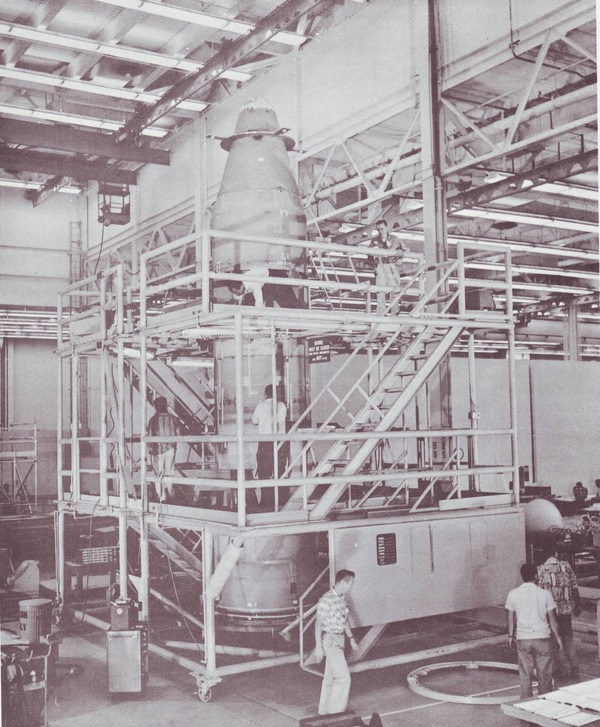 The first Samos reconnaissance satellite atop its Agena spacecraft/upper stage at Vandenberg Air Force Base. (credit: USAF) |
Despite the lack of progress on readout technology in the years since the Samos cancellation, the development of other photographic reconnaissance systems offered promise for readout. The high-resolution film-return GAMBIT-1 [KH-7] satellite, which entered service in summer 1963, proved to have excellent camera pointing, something that was required for a readout system with a narrow field of view. The development of longer lifetime equipment for satellites by the mid-1960s offered the possibility for readout, which also required longer lifetime components. [21]
Because the specific technology used for Samos was considered obsolete by the reconnaissance experts, in 1963 the National Reconnaissance Office agreed to allow NASA to use the technology in its Lunar Orbiter spacecraft. Lunar Orbiter did not have the same resolution or other requirements as a satellite in low Earth orbit. Late in 1964, US intelligence agencies intercepted pictures taken by a Soviet Moon probe and learned that the Soviet Union was operating a readout reconnaissance system with 75-foot (23-meter) resolution capability.[22]
In January 1965, Director of the National Reconnaissance Office Brockway McMillan sent a long, detailed memo to Secretary of Defense Robert McNamara discussing various NRO efforts and studies to “develop the capability for instantaneous satellite reconnaissance” with at least three-foot ground resolution. McMillan indicated that he was replying to a request from McNamara based upon the Defense Secretary’s interest in how satellites could be made more relevant to “monitoring the arms control agreements, tactical uses, etc.”
McMillan indicated that the options and technologies that the NRO was then exploring included processing film recovered from space aboard the aircraft transporting it to Washington, land recovery of film using maneuverable reentry vehicles, faster launch times for satellites, and numerous other options. McMillan mentioned the Samos program, and wrote that electronic readout was “an attractive objective.” But he did not indicate that NRO was currently undertaking any work in that area.[23] (see “Movements of fire and shadow: The X-23 PRIME reentry vehicle and American satellite reconnaissance,” The Space Review, March 5, 2018.)
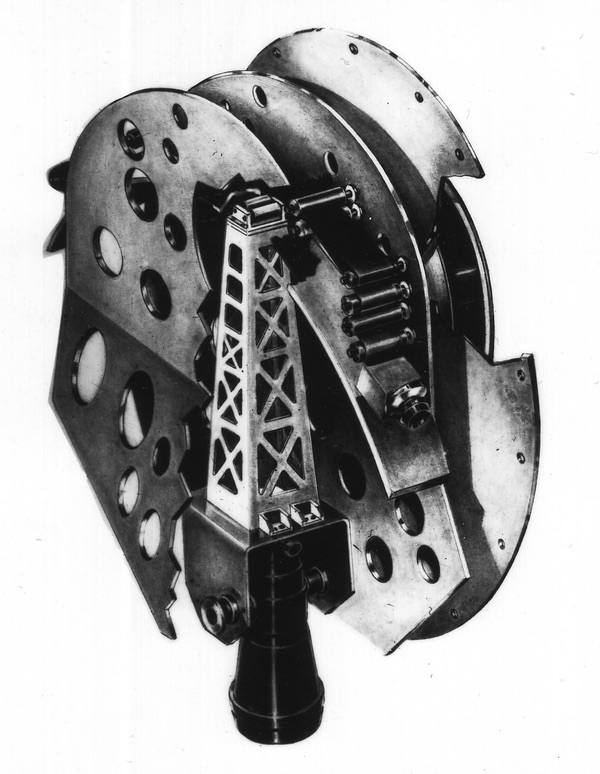 Cutaway of the camera system for the KH-1 CORONA reconnaissance satellite. Unlike Samos, CORONA scanned film that was stored in a reentry vehicle and returned to Earth. Although this took longer for film to reach interpreters, CORONA took thousands of images in a short period of time, meaning that the intelligence take from each mission was significant. (credit: NRO) |
In summer 1965, Brigadier General John L. Martin Jr., who had taken over from Greer as director of SAFSP, sponsored the “GAMBIT Readout Experiment,” which had the goal of testing in orbital operation a combination of readout devices and GAMBIT optics. The goal was to fly a satellite that could transmit imagery of four feet (1.2 meters) or better, covering “a useful number of targets per day.”[24] This was to be an experiment, not an operational system. But no actual space test was undertaken. Martin’s proposal was made when there were major fights and other procurement decisions at the NRO, and the turmoil may have led to its quick demise. However, two technology studies were funded by NRO, undertaken by Bell Telephone Laboratories and CBS Laboratories.[25]
In January 1966, the Committee on Overhead Requirements (COMOR), which established requirements for both photographic and signals intelligence satellites, indicated there was need for quick response satellite imagery and concluded that readout capability for GAMBIT would be a worthwhile investment.[26] Although it is not entirely clear, this statement from COMOR may have prompted the NRO to propose a new operational spacecraft known as Film-Readout GAMBIT, usually shortened to FROG. Whereas the GAMBIT Readout Experiment was a proposal for an experimental test, FROG would be based upon the high-resolution GAMBIT-3 satellite that was just entering service and be an operational imagery satellite. GAMBIT-3 used a powerful camera to expose large format film in long strips. The film was wound up into a reentry vehicle which would later separate from the spacecraft, enter the atmosphere, and be recovered in mid-air while hanging from a parachute. FROG would replace the reentry vehicle with a system for developing the film and scanning it with a laser—an improvement over Samos’ flying spot scanner. The scanned film would be converted into electronic analog signals which would be transmitted to a ground station.
The new proposal was for FROG to operate for 30 to 90 days, be able to read out imagery three to four times each day, transmit to a ground station, and provide a ground resolution of three to five feet (0.9 to 1.5 meters). While an image might be available in as little as 20 minutes after it was obtained, in other cases it might take five days between the time a target was photographed and when the image was transmitted to a ground station. If the FROG proposal was accepted, its proponents believed that it could achieve initial operational capability by November 1968.[27]
John S. Foster Jr., Director of Defense Research and Engineering, wrote to Lieutenant General Joseph Carroll about the new technology capability. Carroll was the head of the Defense Intelligence Agency, the DoD’s equivalent to the CIA. Foster noted that an early demonstration scanning system had “remarkably good” performance, “resulting in relatively little resolution degradation.” But Foster warned that it would be difficult to justify the cost of such a system “if a crisis management situation at some unknown time in the future was its only justification.”
Foster wanted Lieutenant General Carroll’s input on “what current intelligence needs this type of system can satisfy and your view of what possible new concepts in intelligence collection could be developed given the availability of such technology.”[28]
| The June 1967 Six Day War in the Middle East once again raised the issue of crisis reconnaissance. |
In March 1966, Carroll replied to Foster about the value of readout to intelligence collection. “DIA has previously stated the requirement for a quick response, near-real-time readout satellite reconnaissance system as a matter of highest priority.” Although the GAMBIT readout system would not meet all of DIA’s requirements, it would provide “a unique high resolution readout capability which represents a most important breakthrough in providing the timely response so critical for intelligence in crisis situations.” Carroll continued: “The more sophisticated systems which may respond to the total requirement appear to be in the 1972-1975 time frame, therefore, the G-3/RO appears to be a logical and practical interim system in meeting this requirement. Nevertheless, crisis management alone is probably not sufficient justification for continued development especially from the standpoint of cost effectiveness.”[29] Carroll’s memo is the first known mention of flying an interim readout system based on GAMBIT to be followed by a more sophisticated system in the 1970s.
The GAMBIT-3 satellite that was about to launch for the first time was intended to provide high-resolution photography for detailed technical data to support analysis of Soviet advanced weapon systems and technology. For example, it could produce accurate measurements of the diameter of a missile, or the details of a ship under construction. This was a vital mission, but it was not the highest priority or the greatest need for the intelligence community. Carroll noted that more than 50 percent of the required intelligence information could be provided by a satellite with approximately three-foot (one-meter) ground imagery. “This includes priority indications/warning targets as well as surveillance objectives.” The HEXAGON satellite was then under development and when it was launched a few years later would—if it worked properly—provide the majority of the required imagery. “The G-3/RO system which is predicted to have a comparable resolution to the HEXAGON and a capability to photograph over 300 targets per day on a 30-day mission, can effectively augment the HEXAGON in a surveillance role and provide for increased flexibility of collection activities because of the near real-time readout capability.”[30]
Carroll explained that intelligence collected on a specific Soviet activity that was deleted from the report—but was probably strategic forces communications exercises—was currently inadequate. “Frequently it is difficult if not impossible to determine if activities detected are in fact occurring or are merely exercises; and activities conducted under complete or partial communications security may not be detected at all,” Carroll wrote. [31]
Carroll considered the readout system to be complementary to the GAMBIT-3 and HEXAGON film-return systems “for it will provide increased flexibility in operations and the opportunity for new and unique collection methods.” It could be phased in to “provide an economical mix of vehicles in the schedule which would not exceed the number of launches planned for that time period.”[32]
In August 1966, the NRO’s Executive Committee, or ExCom, which had been created to establish policy for the NRO and negotiate disputes, and was chaired by the Deputy Secretary of Defense, met to discuss various national reconnaissance issues. The ExCom included representatives of both the Air Force and the CIA, and during this meeting they approved funding for CBS and Bell Telephone Laboratories to continue research on readout technology at least through January 1967.[33]
On November 17, 1966, the Committee on Overhead Requirements (COMOR), squashed the GAMBIT readout program by indicating that there was no urgent requirement for a crisis warning satellite system—contradicting its January conclusion.[34] Despite this, NRO officials sought to preserve the ability to launch a vehicle with readout by January 1969. They planned for three sets of flight hardware. Their plan to keep the program alive involved performing minimum hardware change studies that looked at using the GAMBIT-3 vehicle with the reentry vehicle section removed and a read-out module added, and changing the film speed drive for a higher orbit: 206 nautical miles (382 kilometers), as opposed to the more typical GAMBIT-3 orbit of about half that altitude. Additional batteries would permit a lifetime of 21 days, greater than that planned for GAMBIT-3 missions, but less than the 30 days originally planned for the FROG mission. But Alexander Flax, the Director of the National Reconnaissance Office, called a halt to the component development program.[35]
What is unclear from existing records is exactly what technologies were being worked on and by whom. Although it has not been revealed in declassified documents, presumably Bud Wheelon’s 1963 directive to Les Dirks resulted in the CIA providing funding for imagery sensor work at Bell Telephone Laboratories as part of the ZOSTER project. But it is unclear if the NRO provided Bell with additional funding starting in summer 1965 for new work, or if that contract funded work on the electro-optical imaging technology that had so impressed Wheelon and Dirks several years earlier.
By January 1967 a bimat technique of film readout using a laser to scan exposed and developed film (similar to that on Samos) had been advanced to the point where program managers believed it could be applied directly to the GAMBIT-3.[36] Despite the promise of this technology, SAFSP director Brigadier General John Martin opposed a suggestion that his organization adapt the laser-scanning system for aircraft. He claimed this was not possible because of personnel shortages, lack of aircraft expertise, and other work undertaken by SAFSP. But the scanning technique was adapted to ground elements of a classified photographic transmission system used in Vietnam. [37]
The June 1967 Six Day War in the Middle East once again raised the issue of crisis reconnaissance. But the conflict was so short that there was little opportunity for United States involvement and thus little obvious benefit for even a near-real-time reconnaissance system. As a result of the war, the United States Intelligence Board asked NRO to look into the feasibility and cost of a collection system.[38]
In early 1968, the Committee on Imagery Requirements and Exploitation, known as COMIREX, which had replaced the COMOR in establishing imagery requirements for satellites, produced an analysis of the utility of photographic reconnaissance satellites for indications and warning. COMIREX’s job was to establish the requirements for reconnaissance satellites and to select the targets that would be photographed on individual missions. COMIREX hypothesized a two-satellite indications and warning constellation with 2.5-foot (0.75-meter) resolution. The satellites would photograph between 70,000 and 140,000 designated targets each year. COMIREX stated that “our requirements should be interpreted as calling for a flexible system that can carry out the warning/indications role and at the same time possess a capability to assist in satisfying routine, current intelligence, and special reconnaissance tasks.” That implied transmission to a ground station within an hour.[39]
According to NRO historian Robert Perry, “SAFSP, and for the most part the NRO staff in Washington, usually favored a relatively conservative, incremental growth approach to the operational employment of new photo-reconnaissance technologies. CIA reconnaissance specialists… consistently urged more adventuresome approaches.”[40] By 1968, ZOSTER had been renamed to ZAMAN, but was frequently referred to as the “electro-optical imaging” or “EOI” system. The CIA had firmly decided upon this technology and was opposed to any form of film-based readout that the NRO—and SAFSP—was pursuing. Whereas most discussion of a near-real-time reconnaissance system up to this time had been initiated and propagated by SAFSP and the NRO, starting in 1968 the CIA and its advisors became increasingly involved in advancing ZOSTER and EOI technology.
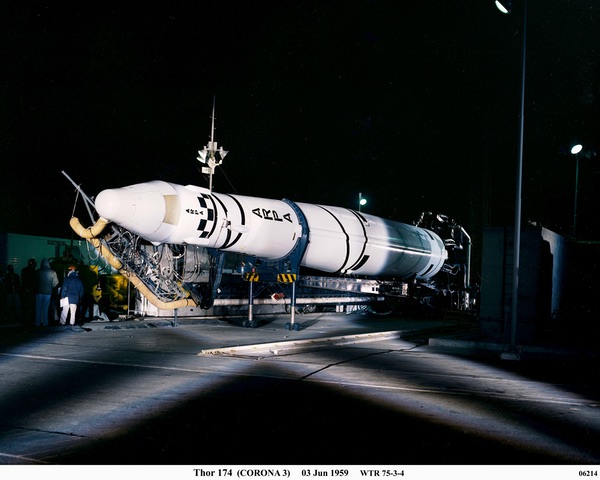 CORONA reconnaissance satellite being prepared for launch from Vandenberg Air Force Base. By the early-mid 1960s, CORONA missions were launching on an almost monthly basis, returning large amounts of film covering many targets within the Soviet Union and elsewhere. Although the photos were at least days if not a week or more old before they reached interpreters, there was so much imagery that the intelligence community struggled to process it all. |
In August 1968, Soviet tanks rolled into Czechoslovakia to suppress a growing independence movement. Shortly before the invasion, a CORONA satellite returned its first film return vehicle to Earth. The photographs had been taken too early to show clear signs of the pre-invasion buildup of Warsaw Pact forces. The CORONA satellite then returned its second film return vehicle with clear evidence of the impending invasion, but the film was recovered too late, only after the invasion had occurred.[41,42] Although the invasion and the experience of various satellite collection systems should have initiated more intensive study of the need for crisis reconnaissance, this did not occur. This remains one of the persistent puzzles about American satellite reconnaissance during the 1960s: there were examples where faster reconnaissance could have been valuable for decision makers, but intelligence officials did not even choose to study the issue of timeliness of reconnaissance imagery.
| This remains one of the persistent puzzles about American satellite reconnaissance during the 1960s: there were examples where faster reconnaissance could have been valuable for decision makers, but intelligence officials did not even choose to study the issue of timeliness of reconnaissance imagery. |
In October 1968, a panel chaired by Edwin “Din” Land completed its review of technology for real-time readout, delivering a formal report in March 1969. Land reported to President Johnson’s Science Adviser Donald F. Hornig that “the necessary technology for a ‘see it now’ system has become available.” Land believed that system development could start in 1969. Land stated that three existing capabilities made it possible to pursue such a system: satellites capable of operating a year or more in orbit, high data rates via satellite-to-satellite relay, and the emerging maturity of electro-optical-imaging technology.[43]
Land was the founder of Polaroid and had been involved in advising the government on top-secret reconnaissance cameras since the 1950s. Land had invented the Polaroid camera, which made it possible for photographers to turn their images into a photo very quickly and had earned him a reputation as a genius, as well as making him quite wealthy. Land was highly influential and respected, and had been involved in advocating for CORONA, CORONA’s stereo capability, and development of a higher-resolution optical system for GAMBIT-3. His opinions carried enormous weight within the government. Din Land became the driving force behind the development of near-real-time satellite reconnaissance from this point forward, and the primary opponent to the NRO’s FROG concept.
Land was not interested in film readout and believed that electron beam scanning, a return-beam vidicon, and electro-optical imaging using a line array of solid state sensors were all better technologies. The latter was being conducted by a CIA-sponsored program by a still-classified contractor that was most likely Bell Telephone Laboratories. “We are especially attracted to the solid state array,” Land explained, because of its lack of moving parts and no electron optics. But Land’s panel also believed that the vidicon approach should be continued through exploratory development.[44] The ultimate goal, Land argued, was “essentially instantaneous information from an always available sensor.” In the panel’s view “the potential value of such a system is so great that all applicable technologies, component development and systems studies should be funded concurrently and at a level adequate to allow system definition about a year from now—if necessary, at the expense of some current operating capability.”[45]
The NRO’s Executive Committee met in November 1968 and NRO Director Flax declared that “if it were deemed imperative to go for expedited development of a readout system at this time it would have to be film readout.”[46] ExCom did not approve development of a system, but dramatically increased research funding for readout.[47]
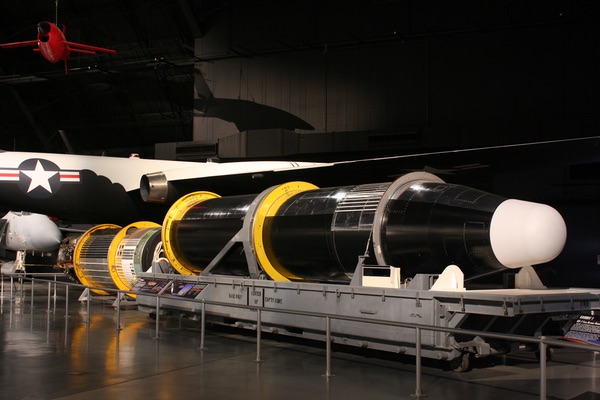 GAMBIT-3 satellite at the National Museum of the United States Air Force. By the latter 1960s, the NRO was evaluating replacing the film-return equipment at the front of the satellite with a film processing and scanning system. This was called the Film Read-Out GAMBIT, or FROG, and could enable images to be relayed to the ground within hours after they were taken. (credit: Dwayne Day) |
In March 1969 Flax urged a cautious approach to electro-optical imaging technology. Flax pointed out that only one readout system had been developed and demonstrated, but several other approaches were promising. Because they were all in such early stages, it was not possible to predict cost, effectiveness or availability. Reliability and wear-out limitations of components were the greatest problems in development for laser-readout. “It does not seem advisable to initiate a full-scale development of a laser-scan system at this time,” Flax stated. The limiting factor for such a system was its film capacity. Flax estimated that from three to five years would be necessary to carry a system to first flight, whereas four to five years would be needed for the vidicon system, and the ZAMAN electro-optical imaging system would require four to five years after demonstration of the array and transducer feasibility, which was not going to be possible until 1970.[48]
Flax believed that the transducer element—the device that converted the light coming through the optical system into electrical signals for transmission—would be the critical component. For any electro-optical imaging system, any array of light detecting sensors had to be big enough to scan the entire frame, which would be challenging.[49]
CIA official John S. Crowley disagreed with Flax’s characterization of electro-optics technology and argued that solid-state arrays were at least as good as the CBS dielectric tape camera. He thought that the NRO had overstated the cost of the ZAMAN system and understated the cost of developing the laser-scan system. He also indicated that the CIA had determined that the laser-scan readout system that Flax was proposing should not be considered as a realistic competitor to the ZAMAN system.[50]
For the next several years, FROG and ZAMAN would be at the center of an increasingly contentious fight. The CIA and its champions—primarily Din Land—were in favor of pursuing ZAMAN first and only, and apparently everybody else, including most members of the ExCom as well as Flax and the leadership of SAFSP, preferring pursuing FROG first, followed by ZAMAN at a later date.
| Soon, the Nixon administration’s interest in budget cutting would begin taking casualties among reconnaissance satellite programs. |
When Richard Nixon was sworn in as president in January 1969, he wanted to reduce government budgets and appointed people in his administration who sought ways to do that. Many of the key actors involved in national reconnaissance issues changed, including the Deputy Secretary of Defense who chaired ExCom, and the Director of the National Reconnaissance Office. The military and intelligence budgets came under greater scrutiny than before. The intelligence budget problem was looking tight by early 1969, with many projects vying for funding including HEXAGON, the Manned Orbiting Laboratory (MOL) and its DORIAN optics system, and a very high resolution system that was under discussion. The latter could be an entirely new system, a modification of GAMBIT, or a combination of GAMBIT, HEXAGON, and DORIAN hardware. One version of this was briefly known as HEXADOR. To some people, readout was a less urgent requirement than very high resolution reconnaissance. Although the requirements justification for very high resolution, sometimes referred to as “VHR,” remain classified, one driving factor was the need for high resolution images of anti-ballistic missiles in order to evaluate their capabilities.[51]
In May 1969, COMIREX noted the need for an “in depth … and longer term review” of the value of near real-time imagery. In July COMIREX’s committee for exploitation research and development (EXRAND) conducted a briefing on the value of near-real-time systems. By late October, the Defense Department’s Director of Defense Research and Engineering was organizing a panel to look into technologies associated with readout systems. In late November, in a memorandum for the record, the new Director of the National Reconnaissance Office John McLucas and DoD official Gardiner L. Tucker noted that a joint DoD-NRO study was intended to determine “What technological capabilities exist or may reasonably be expected in the near future to permit the development of real-time transmission of imagery? What are the comparative merits of competing technologies toward achieving this capability?”[52]
Soon, the Nixon administration’s interest in budget cutting would begin taking casualties among reconnaissance satellite programs.
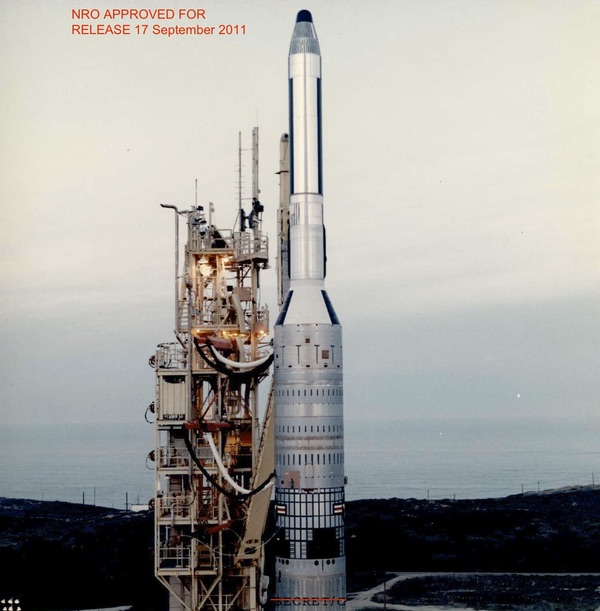 A GAMBIT-3 satellite (also referred to as the KH-8 GAMBIT) on its launch pad at Vandenberg Air Force Base, probably in the late 1960s or early 1970s. GAMBIT-3 was a powerful satellite capable of taking excellent images, but it used the same film-return system that was developed for CORONA, meaning that interpreters in Washington did not see photographs until days or even weeks after they had been taken. (credit: NRO) |
Note: we are temporarily moderating all comments subcommitted to deal with a surge in spam.